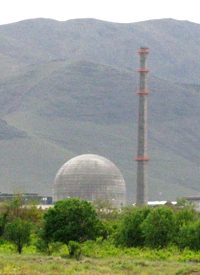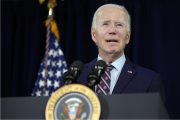
On Monday, a number of media outlets predicted that the International Atomic Energy Agency’s next quarterly report on Iran’s nuclear potential (set to come out this week) would set the stage for a preemptive attack on that country. Experts indicated that the document would reveal the so-called “smoking gun” that would justify a war against Iran. Leaked portions of the report, however, reveal no such information, instead focusing on seemingly idle observations and speculation.
According to the report, Iran has increased its level of uranium enrichment from 3.5 percent to just below 20 percent. Low-enriched uranium was considered acceptable as that is the level needed for nuclear reactors, for which Iran claimed it was developing its nuclear power. Now that the enrichment has reached nearly 20 percent, however, some nations are considering this to be proof of an Iranian nuclear threat — even though weapons-grade uranium is around 90 percent.
CNN has predicted:
The report will contain the most detailed charges to date that Iran’s nuclear program is geared toward weapons development and military use, several Western diplomats briefed on the report told CNN. It will include more data than the organization has previously released on alleged clandestine efforts by Iran to develop technologies to build a nuclear weapon, including computer models of a nuclear warhead. They argue the IAEA studies offer no other explanation for those efforts beyond Iran seeking to develop a nuclear weapon.
The IAEA report also indicates that Tehran has installed new centrifuges, which are being moved into a bunker in Qom to protect them from U.S. and Israeli air strikes.
It also claims that there is satellite imagery of a large steel container used for nuclear-arms related explosives tests; however, as noted by blogger Patrick Henningsen:
The IAEA’s credibility for identifying suspected nuclear facilities has been shot to pieces following its early April fool’s joke delivered last week, claiming that it had satellite imagery of a Syrian nuclear facility. After hyping the finding through the gullible corporate media, it turns out their suspect Syrian site is actually a textile factory.
Overall, though the findings in the report are highly speculative, for some they are sufficient to make the case for war against Iran. Henningsen notes:
While the UN’s IAEA poses as a neutral party, its ambiguous case against Iran is then picked up and run with by Washington, Tel Aviv, London, and the axis power’s newest power play, Nicholas Sarkozy in Paris.
Media robots and warmongers in Washington insisted that Iran has made “computer models” of a nuclear warhead. Meanwhile, Iran expects to trump this latest round of US propaganda by unveiling documents that will detail the US links and funding terrorist operations in the region.
David Albright, a former weapons inspector who heads the Institute for Science and International Security in Washington, has already asserted based on the findings, “We believe if Iran broke out now they could have a bomb in six months. … They’ve done this right in front of our faces.”
Greg Jones of the Nonproliferation Policy Education Centre made even more speculative assertions, claiming Iran could have a nuclear bomb in as little as two months.
And the Bipartisan Policy Centre insisted, “The Islamic Republic of Iran could be a de facto nuclear power before 2011 is over.”
[It] will be followed by a U.S.-European Union push for harsher sanctions against Iran at the U.N. Security Council, where Western powers will meet stiff resistance from Russia and China,” insisted Trita Parsi, an expert on U.S.-Iran relations.
“The primary new information is likely to be any work that Iran has engaged in after 2003…. Iran is understood to have continued or restarted some research and development since then,” said Peter Crail of the Arms Control Association, a U.S.-based advocacy group.
Whether the released report will make any clear and incontrovertible assessments regarding Iran and its nuclear program is unclear, but according to Mark Hibbs of the Carnegie Endowment for International Peace, “The IAEA’s report will not likely contain any smoking guns.”
Some contend the report will provide the basis for a pre-emptive military strike against Iran by Israel; however, Ayatollah Mahmoud Alavi, a senior Iranian cleric, has dismissed this speculation as “empty propaganda,” calling Israel “a cornered cat.”
However, history reveals that Israel’s threats are not empty. In 1981, Israel bombed an Iraqi nuclear reactor, and launched a similar strike against Syria in 2007.
Parsi contends that Israel should be taken seriously. “How much longer can this game of brinkmanship … be pursued before it turns into a self-fulfilling prophecy?”
And cleric Alavi warned, “If [Israel] make[s] such a mistake they will receive a crushing response from the Islamic Republic.”
Some experts believe Israel does not intend to launch the strike, as it does not have the long-range bombers necessary to inflict long-term damage on Iran’s facilities. They believe Israel is merely attempting to pressure the United States and Europe into imposing even tougher sanctions against Iran.
Russia and China have voiced concerns that the report will ignite further tensions in the Middle East, eliminating any chance of diplomacy to address concerns over Iran’s nuclear program.
Russian Foreign Minister Sergey Lavrov declared on Monday:
Our position towards this issue is well known. We think [the use of military force against Iran] would be a very grave mistake fraught with unpredictable consequences.
There is no military solution to the Iranian nuclear problem, or to any other international issues for that matter. We get evidence of that every day when we’re looking at developments around Iraq, Afghanistan and other countries of that region. Military interference only increases the number of victims and human suffering.
The use of force is possible only in two cases under the U.N. Charter: when the right of self-defense is exercised, and when there is a corresponding resolution of the U.N. Security Council. I hope such cases will not emerge.
The White House has been hesitant to issue a statement on the report prior to its official release. Press Secretary Jay Carney commented:
I don’t want to get ahead of the report … [but] I do expect it will echo our concerns. And I think that the fact that Iran continues to misbehave, if you will, is something that concerns not just the United States, but the broader international community. And that international community, because of the actions we have taken, is now focused on pressuring Iran. … You can be sure that we will continue to work to pressure Iran, to isolate Iran.
Photo: IR-40, a heavy water reactor under construction in Arak, Iran



